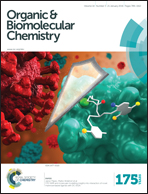The interaction of Mozobil™ with carboxylates†
Abstract
Mozobil™ (1,1′-[1,4-phenylenebis(methylene)]bis[1,4,8,11-tetraazacyclotetradecane], 1, also known as JM3100 and AMD 3100) is a specific antagonist of the chemokine coreceptor CXCR4 and favours the mobilisation from the bone marrow of stem cells, which can be used for autologous transplantation. It is believed that the interaction, of both hydrogen bonding and electrostatic nature, involves a partly protonated form of Mozobil™, LHnn+ and the COO− groups of Asp171 and Asp262 residues protruding from the walls of the pocket of the membrane protein CXCR4. We have investigated, through potentiometric titrations in 0.1 M NaNO3 at 25 °C, the interaction equilibria between 1 (L) and linear dicarboxylates A2−. These studies have demonstrated that the main equilibrium takes place: LH55+ + A2− ⇄ [LH5⋯A]3+, and that the most stable [LH5⋯A]3+ complex forms for A2− = diphenyl-4,4′-dicarboxylate, whose length matches that of LH55+. 1H NMR titration experiments have shown that in the 7–10 pH interval, LH33+, LH22+ and LH+ forms establish π–π interactions with diphenyl-4,4′-dicarboxylate, according to a topological arrangement which excludes the formation of H-bonds. It is finally suggested that, in the pocket of the CXCR4 membrane protein, Mozobil™ operates as a pentammonium cation, which establishes with carboxylate groups of Asp171 and Asp262 strong interactions of hydrogen bonding and electrostatic nature.


 Please wait while we load your content...
Please wait while we load your content...